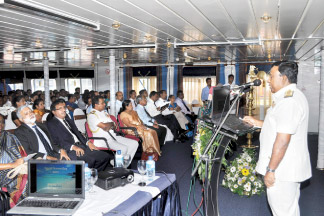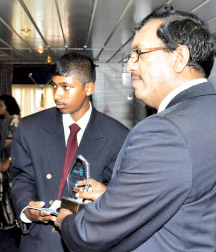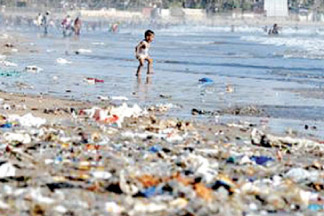|
Listen to the ocean......
Echoes of a million sea shells
by Dhaneshi Yatawara
|

Rear Admiral Daya Dharmapriya delivering the theme speech at the
‘Ocean day’
|
The Ocean, the continuous body of saline water encircling the world,
has given rise to voyages, discoveries, fossil fuels, food and even to
tsunamis and storms creating devastation. It fascinated generations of
poets, artists, musicians and writers. This great water mass covers
almost 75% of the earth and is an immense wealth of resources.
Yet did you know that in every square kilometre of the ocean surface
approximately 13,000 plastic pieces are floating? And the total input of
marine litter put in to oceans worldwide is estimated approximately 1800
tons every day.
As we are all aware the ocean is not merely a large mass of salt
water. It is another living world. It is the world that emerged before
us the land animals. Life within the ocean evolved three billion years
prior to life on land.
Oceans regulate our climate by redistributing heat around the world.
This determines the climate and wind patterns of the environment where
we live. The ocean has a significant effect on the biosphere. Oceanic
evaporation, as a phase of the water cycle, is the source of most
rainfall.
|

Minister Anura Priyadarshana Yapa handing over prizes at the
Ocean Day competition held for schoolchildren |
Ocean resources are vital considering the country’s development
goals. Thus it is essential to protect this unique environment while
getting its support towards sustainable development for the country,
said Environment Minister Anura Priyadrashana Yapa addressing the Sri
Lankan ‘world ocean day’ program held last week.
He emphasized the need for implementing existing legal protection
network by the authorities more strongly than ever before.
Yet it seems that people still believe that the ocean had an infinite
capacity to absorb and remove waste and by products. Over the past few
decades the range of waste and hazardous material dumped into the sea
increased along with its quantity posing a serious threat to the ocean
eco system.
Plastic trash, oil spills, radioactive and nuclear waste, sewage
effluence toxic industrial waste, pesticide residues etc are major
pollutants. Thus tens and thousands of marine fauna and flora are
crippled or killed each year.
According to marine biologists, as many as 30,000 fur seals are
estimated to become entangled in lost or discarded plastic fishing nets
or choked to death in plastic cargo straps. The resulting damage to
marine life due to pollution is difficult to access. Yet the non
accessed damage to the ocean done in the past is bringing tragedy to us
today.
Feeling the pain, mankind today is dedicating each marked day of the
year for an issue related to mitigate global warming, climate change or
desertification. We just passed World Ocean Day on June 08. The theme
was ‘our oceans greening our future’.
|

Plastic-sea lion - A sea lion wounded by a fishing net |
In order to achieve the target of the Mahinda Chinthanato make Sri
Lanka the wonder of Asia the Marine Environment Protection Authority
(MEPA), under the instructions of Environment Minister Anura
Priyadarshana Yapa aims at establishing green harbours.
This is to make the fishing community more environment friendly. As
mentioned above larger the fishing community get heavier the waste gets
that dumped in to the sea. Thus it is essential to make a new strategy
to correct the errors of this highly economical trade.
Sri Lanka possesses territorial waters in an area of 21,700 square
kilometres up to 12 nautical miles. Beyond, up to 200 nautical miles, is
our Exclusive Economic Zone with an area of 465,800 square kilometres.
(This is seven times the size of country’s land area.) To make Sri Lanka
the Centre of the Asian Silk route once again taking the advantage of
its unique geographic location is the future vision of the Mahinda
Chinthana.
|

Plastic-pollution - Never let this happen to Sri Lanka! |
As highlighted by Professor Ranjith Senarathne in the Marine
Environment Protection Authority supplement marking the 2010 World Ocean
day, according to the last comprehensive survey conducted in 1979 - 80
an annual harvest able yield of 250,000 tons is possible from the
coastal fishing and another 90,000 - 150,000 tons from the rest of the
Exclusive Economic Zone (EEZ). Under the UN Law of the Sea, Sri Lanka is
entitled to claim for an extended area of the sea bed where the
thickness of the sediment layer exceeds one kilometer.
If the submissions are accepted Sri Lankan EEZ will expand which then
will be 23 times the land area. Apart from the rich fauna and flora of
the zone, the area is concentrated with minerals and hydrocarbons.
Minerals include the expensive ones that are in high demand such as
titanium, zirconium, thorium, cobalt, nickel, copper and manganese.
Hydrocarbons are oil and natural gas.
Ocean wealth can be categorised in to four. i.e. - ocean resources,
ocean advantage, ocean environment and islands,said Director General of
the Sri LLanka Coast Guards Rear Admiral Daya Dharmapriya giving the
theme speech at the World Ocean Day Sri Lankan celebration.
Considering the ocean resources it is estimated that the world’s food
harvest from the sea is about 80 million tons per year, Rear Admiral
Dharmapriya said. Trade, shipping, port facilities, maritime industries
and the renewable energy from wind, tides, currents and waves can be
categorised as ocean advantages.
Ocean environment can be categorised in to three i.e. Coastal zone,
Marine environment, Climatology.
The Coastal zone includes ecosystems such as mangroves, shallow coral
reefs, lagoons and estuaries as well as socio- economic activities that
includes tourism related businesses as well as taking sea water for
personal usage.
The Sri Lankan sea is hyped with maritime activities including ports
and harbours, maritime transportation, fisheries and maritime
industries, exploration and exploitation of marine and sea bed
resources, sports and recreation, hydrographic and oceanographic
research activities, submarine cables and under water pipes, defence
activities etc.
“On an average every day there are over 160 ships pass through the
traffic separation zone located south of head lighthouse in Dondra
point, Rear Admiral Dharmapriya added. “As the present Traffic
Separation Zone is located at a sea area highly populated by whales, it
will be advisable to take the zone further south in order to protect
valuable species,” he said
As he further explained at any given time there are about 9,000 ships
at sea, moving 3,500 million tons of cargo. According to statistics
available 60% of region’s containerized cargo is transshipped through
Colombo harbour. Port of Colombo have handled 4.1 million TEUs
(Twenty-foot equivalent units) - a measure used for capacity in
container transportation. 2009 recorded a 19.4 % growth and by end of
2011 it is expected to grow up to 4.4 million. Sri Lankan ports will
have the capability in the future even to accommodate Malaccamax ships,
he said explaining the evolution of Sri Lankan ports.
Malaccamax is a naval architecture term for the largest size of ship
capable of fitting through the 25 metres (82 ft)-deep Strait of Malacca.
”Sri Lanka has more than 42,000 fishing vessels involved in fishing
everyday. Approximately 3200 multi-day fishing vessels operate in EEZ
and in high seas, he added. An estimated 12.5 million fishermEn
operating from some three million vessels, lands around 90 million tons
of fish per year.
The fishing industry provides a livelihood directly or indirectly,
for about 200 million people.
Today in Sri Lanka the coastal line is heavily populated; even in the
world. Apart from houses, industries, hotels, restaurants, road side
eateries, business establishments, shops, schools, filling stations etc
are concentrated within few kilometers from the sea.
Increase in the number of activities in the seas and oceans can
increase the number of crimes at sea, Coast Guards chief said.
Considering the environmental crimes 70% of pollution of the oceans has
its source in human activities on land. These activities include
agriculture, industry, urbanization and its resulting outputs.
Though reported in less numbers piracy and armed robberies do happen
in the Indian ocean. Over exploitation of marine resources is another
crime. Apart from those a long list of unethical and cruel activities
identified as crimes at sea globally do happen in silent deep blue seas
of our country.
The terrorist threats are no more at the sea. Thus the increase in
the number of sailors, fishermen and tourists traveling via sea is
inevitable. Understanding the negative repercussions to the country from
crimes at sea the Sri Lanka Coast Guards was established in order to
enforce law in the seas.
They were the police of the sea. The Sri Lanka Coast Guard was the
brainchild of President Mahinda Rajapaksa who as the then Minister of
Public Security, Law and Order saw the importance and the urgency of
setting up such an agency to protect the seas around the country.
Subsequently, he presented a Cabinet paper in January 2008 to appoint a
Director General for the Sri Lanka Coast Guard.
Following this move, Rear Admiral L. Daya Dharmapriya was appointed
as the first Director General of the Sri Lanka Coast Guard by the
Cabinet of Ministers on March 27, 2008. President Rajapaksa as the Chief
Guest, ceremonially inaugurated the Coast Guard agency on March 4, 2010.
Their service is required to prevent illicit activity in Sri Lankan
waters like smuggling and poaching, as well as pollution prevention and
search and rescue.
The coast guard has been a long-felt need especially given the
increasing pollution of the sea around the island and illegal activity
such as human smuggling.
nt task of the agency is to protect the territorial waters of the
country as promulgated in Act No. 14 of 2009 of the Coast Guard.
The Sri Lanka Navy, at some point of time when Emergency Laws are
lifted will not be empowered to carry on with such tasks. Coastguard
officers who are designated as Peace Officers are empowered to enforce
local and international laws.
The Coast Guards are given the authority under the constitution to
enforce laws related to dumping of pollutants into the sea.
Thus the coordination and combined efforts of MEPA and Coast guards
along with the Environment Ministry and every single government
institute related to marine pollution prevention would give strength to
the laws protecting our seas.
The sea is polluted enough and more and now it is high time to
strengthen the ground work. |

